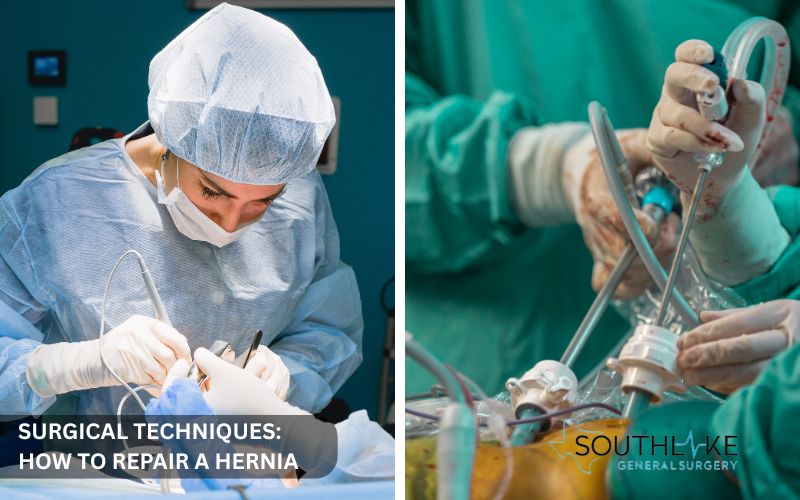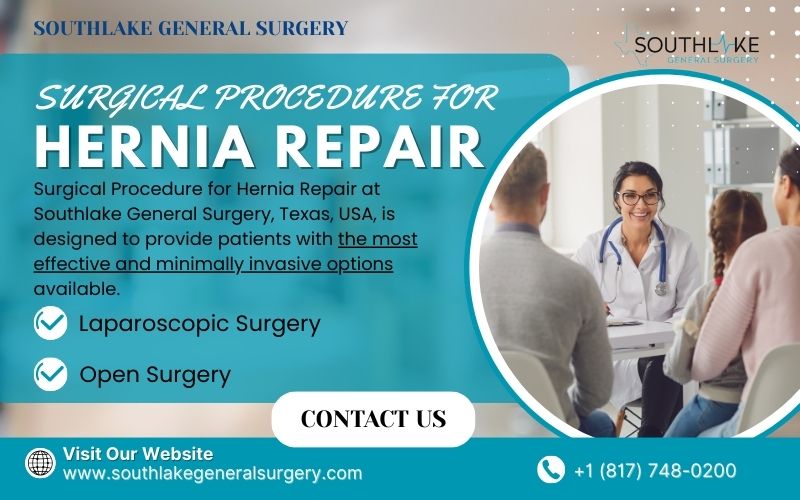Surgical Procedure for Hernia Repair at Southlake General Surgery, Texas, USA, is designed to provide patients with the most effective and minimally invasive options available. Understanding the process can ease anxiety and prepare you for a smooth surgical journey.
Being prepared for hernia repair surgery can ease your mind and help you feel more at ease. Hernia repairs can be done in three different ways: open surgery, laparoscopic surgery, and robotic repair. A mesh is often put in to strengthen the weak spot in the abdominal wall.
You will be informed about the type of anesthesia that will be utilized prior to your surgery. For bigger repairs, general anesthesia is usually used. For smaller hernias, local anesthesia might work. The physician will determine the most suitable course of action for you, considering your medical background and the specific type of hernia present.
Key Highlights
- A hernia happens when an organ or tissue protrudes through a vulnerable area in the abdominal wall.
- Surgery is often required to fix a hernia because medication will not help.
- Two of the most frequent surgical techniques are open surgery and laparoscopic treatments, which involve small incisions.
- Hernia surgeries have excellent results and a low chance of recurrence.
- Recovery time varies based on the type of surgery, but many patients can start light activities within a few days.
- Special care teams and improved surgical methods boost recovery and make life better after surgery.
Understanding Hernia and Its Impacts

A hernia happens when an organ or tissue breaks through a weak spot in the abdominal muscles. This can create a noticeable bulge. Some hernias do not cause any symptoms, but others can be painful. This pain can make everyday tasks hard to do. If you do not treat a hernia, it can get worse and lead to serious problems, such as tissue strangulation.
Hernias can create issues that impact both the body and emotions. Symptoms such as groin pain, changed movement patterns, and a need for pain medication are possible. Luckily, surgery can relieve the pain and help keep things stable for a long time.
What is a Hernia?
A hernia is a health issue. It occurs when an organ or tissue pushes through the abdominal wall. This happens due to weak muscles or connective tissue. A weak spot usually forms in areas like the groin area or belly. This can cause pain or discomfort. Activities such as heavy lifting, constant coughing, or past surgeries can result in hernias.
Hernias in the abdominal wall can be either mild or severe. A lump may appear, and it may enlarge when you stand up or cough. This bulge can get smaller when you lie down. It’s important to treat hernias so they do not get worse over time.
Hernias, including inguinal and femoral hernia types, frequently occur in the genital area.. This can lead to pain or pressure, which makes daily activities hard to do. Some hernias may not change for years, but surgery is usually required for the best and safest results.
What is a Hernia Repair?
A hernia repair is a surgical procedure designed to correct a hernia by returning the protruding tissue or organ into its proper place and reinforcing the weak abdominal wall. This can be achieved through various techniques, including open surgery or minimally invasive laparoscopic methods.
During the operation, the surgeon generally employs sutures or synthetic mesh to reinforce the region, thus minimizing the chance of recurrence. The specific approach to hernia repair depends on factors such as the type of hernia, its size, and the patient’s overall health.
Common Types of Hernias
Different types of hernias affect specific regions of the body.
- Inguinal Hernias: These are located in the groin region. Compared to other types of hernias, this one primarily affects men.
- Femoral Hernias: These occur in the upper thigh region. There is an increased chance of problems, and these occurrences are more likely in women.
- Umbilical Hernias: These are near the belly button. They often occur in newborns, but adults can get them too.
- Hiatal Hernias: It is a situation in which a section or segment of the stomach extends into the chest cavity. This could lead to signs of acid reflux.
- Incisional Hernias: These happen when the abdominal muscles become weak. This can be due to scars from past surgeries.
Each type shows different signs. These signs can be mild, but they can also be serious. Knowing these differences can help people decide when to see a doctor for a checkup or surgery.
Symptoms Indicating the Need for Surgery
Signs you might need for hernia surgery include pain at the hernia site and not being able to control symptoms with medicine. Hernias usually cause a visible lump in weak areas like the groin or abdominal wall. You might need to have emergency surgery if you experience unexpected swelling or pain.
If you experience pain in the vulnerable area, it is advisable to consult a physician. Sometimes, serious issues like intestinal blockage may happen. Getting treatment when you need it is crucial.
If you’re experiencing fever, redness, and pain, it may be necessary to seek emergency surgical intervention. Be vigilant about observing your symptoms. If complications are not treated, they can become serious.
It’s important to note if your pain gets worse, even while resting or taking medicine. This can assist you in obtaining the appropriate assistance.
Preparing for Hernia Surgery
Preparing for hernia surgery means knowing what will happen and following the steps before the surgery. Patients need to meet with their care team. This team includes Dr. Valeria Simone, MD, an expert on hernias. This meeting helps with a complete medical checkup. It includes physical exams and imaging tests to see how serious the hernia is.
Before undergoing the procedure, it’s important to get yourself ready both mentally and physically. Patients may need to change some habits. They should stay away from heavy work and ask questions about anesthesia or care after the surgery.
Consultation with Dr. Valeria Simone
A visit with Dr. Valeria Simone provides the right care for each patient. During this appointment, the healthcare team will review the patient’s medical background. They will pay special attention to any past surgeries or health issues that might impact the hernia repair results.
Dr. Simone takes a complete approach. She explains what type of hernia needs surgery and reviews the different hernia repair methods. The consultation also covers possible risks and describes what recovery will be like after the surgery.
Patients can feel comfortable discussing any worries they have about anesthesia, pain management, or how surgery might affect their daily life.
When it comes to hernia repairs, Dr. Simone is the go-to expert for minimally invasive procedures. This type of surgery focuses on providing great results while ensuring patient care is a priority.
Tests and Diagnostics Prior to Hernia Repair Operation
We need several tests to find out if someone has a hernia. First, we start with a physical exam. After that, we do imaging and lab tests. Before surgery, we also check for risks. These risks include blood clots or infections. Their presence can complicate the surgery unnecessarily.
In physical exams, we look at the size of the hernia and where it is located, like in the groin area or the upper abdomen. Tools like ultrasound or MRI help us see the hernia’s shape clearly.
We also do blood tests to check if a patient is ready for surgery. This provides the care team with assistance in selecting the option of anesthesia that is the safest. Good tests help doctors like Dr. Simone plan the best way to do the surgery.
How to Prepare Mentally and Physically for Surgical Hernia Repair
Mental preparation for hernia repair involves knowing about the surgery and managing stress. Patients should understand the types of anesthesia, the care plans, and the recovery time. Learning this information can help ease their concerns.
In the days leading up to your surgery, it’s crucial to adjust your physical activity. You should avoid putting strain on the weak area affected by the hernia. Consuming nutritious foods and staying hydrated can enhance your well-being throughout the recovery process.
On the day of the procedure, individuals must adhere to essential guidelines. They should not eat or drink anything. It’s best to wear comfy clothes.
Additionally, ensure you have arrangements in place for your return home following the surgery. Staying calm and following these instructions can help ensure a successful surgery.
Surgical Techniques: How to Repair a Hernia

When it comes to hernia repair surgery, you have two options: open surgery or laparoscopic surgery. The size and location of the hernia are essential factors in determining the best treatment method. Your overall health is also an important factor to think about.
Both techniques focus on addressing vulnerable regions in the body using surgical mesh or sutures. Laparoscopic surgery is less invasive, which means recovery might be faster.
However, the open surgery method is more effective for more challenging hernias. To choose the best method for you, it’s a good idea to talk to an expert like Dr. Simone.
Overview of Laparoscopic Hernia Repair
Laparoscopic surgery offers a reliable approach for hernia repair. It makes small incisions in the body. Surgeons use thin, flexible tools with a camera on them. This helps them see the weak area clearly. This method also helps to lessen pain and scarring.
Patients gain a lot from laparoscopic repair. They recover faster and have a lower chance of developing an infection. This process generally needs general anesthesia. It works best for hernias that are not too large or complicated.
After laparoscopic surgery, people can go back to their usual activities quicker than with traditional open repair. Dr. Simone’s care team supports patients in knowing what to expect during this process.
Overview of Open Hernia Repair
Open surgery is a reliable way to fix hernias. This method is good for larger or recurring hernias. The surgeon just needs to make one cut in the patient’s belly to get to the abdominal wall for the procedure. Subsequently, they reposition the displaced tissue into its proper location. To strengthen the weak area, they use stitches and often include surgical mesh.
Recovery takes more time with open surgery. However, it is really good for tough hernia cases and lowers the chance of a recurrence. There is some risk of complications, but new surgical methods can help reduce these worries.
If you are worried about scars or pain, Dr. Simone’s care team is here to assist you. They will provide you with all the information you need before any open surgery happens.
Deciding the Best Approach on Surgical Repair of Hernia with Dr. Simone
When it comes to hernia repair surgery, Dr. Simone gives patients options. She chooses the best type of surgery for each patient’s needs. Laparoscopic repair is a less invasive option. Typically, it leads to less pain and quicker recovery time. On the other hand, larger or more complicated hernias may be better addressed with open surgery.
When deciding on anesthesia, doctors look at the patient’s health record. This helps keep everyone safe during surgery. Dr. Simone and her care team want to give clear explanations. They assist patients in understanding the advantages of each approach.
The last surgical method is designed to bring good results. It aims to enhance life quality after the surgery.
Post-Surgery Recovery and Care

Recovery after hernia surgery is about managing pain and slowly returning to your usual activities. How long it takes to heal can be different for everyone. It could be just a few days, or it might take several weeks. After the surgery, it’s important to watch for any side effects, drink plenty of water, and make sure the wound is healing properly.
Patients should change their habits to recover for the better. Staying active is important, but it’s key to avoid putting too much pressure on the injured areas. Dr. Simone’s complete recovery method helps people get better little by little. It also aims to keep patients feeling happy.
What to Expect Immediately After Surgery
After hernia repair surgery, doctors watch patients in a recovery room to make sure they feel stable. Some side effects, like mild nausea or tiredness can happen, but they usually go away in a few hours. It is often suggested to take a sip of water and have light liquids after surgery to keep hydrated.
Managing pain during this time means taking the pain relievers your doctor gave you. Gentle activities, like walking, can help prevent problems too. Most patients can go home the same day if the repair is simple. But for more complex surgeries, they might need to stay overnight.
Dr. Simone’s team are constantly on the lookout for indications that patients are making progress. In addition to this, they assist patients with the initial stages of their care.
Long-term Care and Lifestyle Adjustments
Recovering from hernia surgery takes time. For a period of time, it is essential to make certain adjustments to the way you live your life.
For the next few weeks, you should refrain from engaging in strenuous activity and heavy lifting. This helps with healing. Doing light activities, like walking, can help improve blood flow and support your recovery.
You may want to eat better to feel good in your stomach. It may also assist to do workouts that target the abdominal muscles. If you have issues like scar tissue you can address these concerns by scheduling a follow-up appointment with Dr. Simone.
Following your care plan will help you feel better. A return to your regular routine will be facilitated by this as well.
Conclusion
In conclusion, understanding the procedure for hernia repair is crucial if you are dealing with this prevalent condition. Knowing the signs that may require surgery and getting ready both mentally and physically can help you manage your health. New surgical methods, like laparoscopic and open repair, offer good results and easier recoveries.
After surgery, it is essential to follow your doctor’s advice and make lifestyle changes for lasting success. If you have questions or want to discuss surgery, feel free to reach out to Dr. Valeria Simone at Southlake General Surgery. Our team is ready to assist and support you throughout the journey.
Make an Appointment

Dr. Valeria Simone has helped many patients with hernias. She understands the significant impact these can have on everyday living. She is dedicated to offering safe and effective surgery. Her aim is to assist individuals in improving their well-being.
At Southlake General Surgery, we prioritize our patients and their healing journey. We use up-to-date methods that fit each person’s needs. Our team is ready to help patients through consultations, surgeries, and follow-up care. We want to support them in healing and ensure they are happy with their outcomes.
Dr. Simone truly cares about every surgery she does. She makes patients feel at ease, helps them feel confident, and improves their quality of life.
If you need expert help for hernias, reach out to her team at Southlake General Surgery today. To make an appointment, call Southlake General Surgery at +1 (817) 748-0200.
Frequently Asked Questions
What are the possible risks and complications linked to hernia repair surgery?
While hernia repair surgery is generally safe and effective, as with any surgical procedure, there are potential risks and complications to be aware of. These may include:
1. Infection: A risk associated with any surgery, infections can occur at the incision site or deeper within the body.
2. Bleeding: Certain patients might encounter significant bleeding either during or following the procedure.
3. Chronic Pain: A small percentage of patients report ongoing pain after surgery, which may take time to resolve.
4. Recurrence of Hernia: In some cases, the hernia may return after surgery, necessitating further treatment.
5. Nerve Injury: There is a minimal risk of nerve damage during the procedure, which could result in numbness or altered sensation.
6. Adhesions: Scar tissue can form inside the abdomen, leading to complications such as bowel obstruction.
7. Anesthesia Risks: While rare, reactions to anesthesia can occur and may pose additional risks. Understanding these potential risks is important for making informed decisions about your health.
What is the average duration of a typical surgical procedure for hernia repair?
One to two hours is the typical amount of time that is required for a hernia repair surgery to be completed. The time can change based on how complex the hernia is, and the type of surgery being done. Open surgery usually takes longer than laparoscopic techniques. It is best to talk to your surgeon for a more accurate time that suits your situation.
Medically Reviewed By: Dr. Valeria Simone MD
Board-certified General Surgeon at Southlake General Surgery, Texas, USA.
Follow us on Facebook and YouTube.
References:
- Haladu N, Alabi A, Brazzelli M, Imamura M, Ahmed I, Ramsay G, Scott NW. Open versus laparoscopic repair of inguinal hernia: an overview of systematic reviews of randomised controlled trials. Surg Endosc. 2022 Jul;36(7):4685-4700. doi: 10.1007/s00464-022-09161-6. Epub 2022 Mar 14. PMID: 35286471; PMCID: PMC9160137.
- Conze J, Klinge U, Schumpelick V. Hernias. In: Holzheimer RG, Mannick JA, editors. Surgical Treatment: Evidence-Based and Problem-Oriented. Munich: Zuckschwerdt; 2001. Available from: https://www.ncbi.nlm.nih.gov/books/NBK6888/
- Armijo PR, Pokala B, Flores L, Hosein S, Oleynikov D. Current state of robotic use in inguinal hernia repair: a survey of minimally invasive hernia surgeons. Updates Surg. 2020 Mar;72(1):179-184. doi: 10.1007/s13304-020-00709-6. Epub 2020 Mar 5. PMID: 32141046.
- Howard R, Thumma J, Ehlers A, Englesbe M, Dimick J, Telem D. Reoperation for Recurrence Up to 10 Years After Hernia Repair. JAMA. 2022 Mar 1;327(9):872-874. doi: 10.1001/jama.2022.0744. PMID: 35230401; PMCID: PMC8889458.

